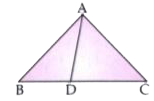If ΔABC~ΔDFE,∠A=30,∠C=50∘,AB=5 cm,AC=8 cm and DF=7.5 cm. Then, which of the following is true?
DE=12cm,∠F=50∘
DE=12cm,∠F=100∘
EF=12cm,∠D=100∘
EF=12cm,∠D=30∘
The correct Answer is:B
Given, ΔABC~ΔDFE, then ∠A=∠D=30∘,∠C=∠E=50∘

∴∠B=∠F=180∘−(30∘+50∘)=100∘
Also, AB=5cm, AC=8cm and DF=7.5 cm
∴ABDF=ACDE
⇒57.5=8DE
∴DE=8×7.55=12cm
Hence, DE=12 cm, ∠F=100∘
Topper's Solved these Questions
- BOOK - NCERT EXEMPLAR ENGLISHCHAPTER - TRIANGLESEXERCISE - Very Short Answer Typw Questions12videos
TRIANGLES
- BOOK - NCERT EXEMPLAR ENGLISHCHAPTER - TRIANGLESEXERCISE - Short Answer Type Questions15videos
TRIANGLES
- BOOK - NCERT EXEMPLAR ENGLISHCHAPTER - SURFACE AREAS AND VOLUMESEXERCISE - LONG ANSWER TYPE QUESTIONS20videos
SURFACE AREAS AND VOLUMES
Similar Questions
In ΔABC,∠C=2∠A and AC=2BC. Then which of the following is/are True ?
View SolutionIn ΔABC,∠B=90∘,∠A=30∘,b=20cm, find a and c.
View SolutionIn ΔABC,∠ABC=∠DAC, AB = 8 cm, AC = 4 cm and AD = 5 cm.

(i) Prove that ΔACD~ΔBCA.View SolutionIn ΔABC,∠ABC=∠DAC, AB = 8 cm, AC = 4 cm and AD = 5 cm.

(ii) Find the length of BC and CD.View SolutionIt is given that ΔABC~ΔEDF such that AB=5 cm, AC=7 cm, DF= 15 cm and DE = 12 cm. Find the lengths of the remaining sides of the triangles.
View SolutionIn ΔABC,∠ABC=∠DAC, AB = 8 cm, AC = 4 cm and AD = 5 cm.

(iii) Find area of ΔACD : area of ΔABC.View SolutionIn ΔABC, angle A=90∘, side AB = x cm, AC = (x+5) cm and area = 150 cm2. Find the sides of triangle.
View SolutionIn ΔABC,∠ABC=∠DAC,AB=8cm,AC=4cmandAD=5cm.

Find BC and CD.View SolutionIn ΔABC , ∠A is right - angled . If AB= 1 cm , AC =3 cm and BC = √10 cm , then find the values of cos B and sin C.
View SolutionConstruct a quadrilateral ABCD in which, ∠A=120∘,∠B=60∘,AB=4cm,BC=4.5cmandCD=5cm.
View Solution

